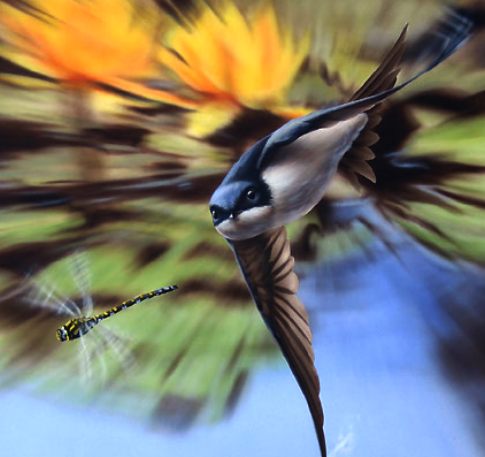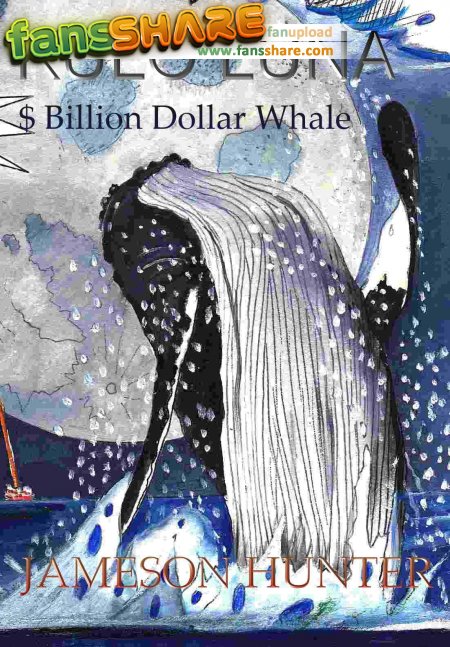HOUSE MARTIN
I was always fascinated by those quaint mud nests, which I usually found under the eaves of country houses. I loved the way that the birds swooped in and out at great speed.
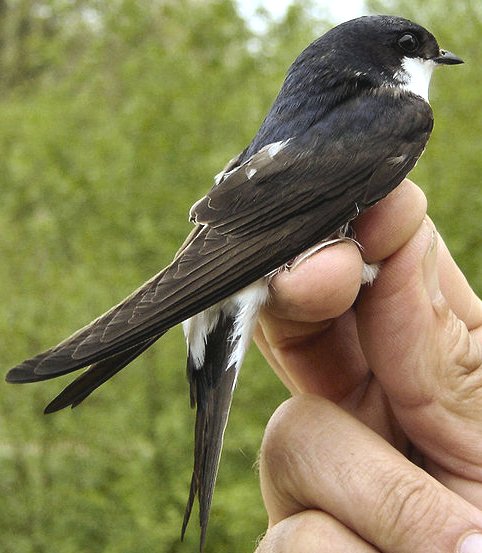
The Common House Martin (Delichon urbicum), sometimes called the Northern House Martin or, particularly in Europe, just House Martin, is a migratory passerine bird of the swallow family which breeds in Europe, north Africa and temperate Asia; and winters in sub-Saharan Africa and tropical Asia. It feeds on insects which are caught in flight, and it migrates to climates where flying insects are plentiful. It has a blue head and upperparts, white rump and pure white underparts, and is found in both open country and near human habitation. It is similar in appearance to the two other martin species of the Delichon genus, which are both endemic to eastern and southern Asia. It has two accepted subspecies.
Both the scientific and colloquial name of the bird are related to its use of man-made structures. It builds a closed cup nest from mud pellets under eaves or similar locations on buildings usually in colonies, but sometimes fouling below nests can be a
problem.
It is hunted by the Eurasian Hobby (Falco subbuteo), and like other
birds is affected by internal parasites and external fleas and mites, but its large range and population mean that it is not threatened
globally. Its proximity to man is generally accepted leading to some cultural and literary references
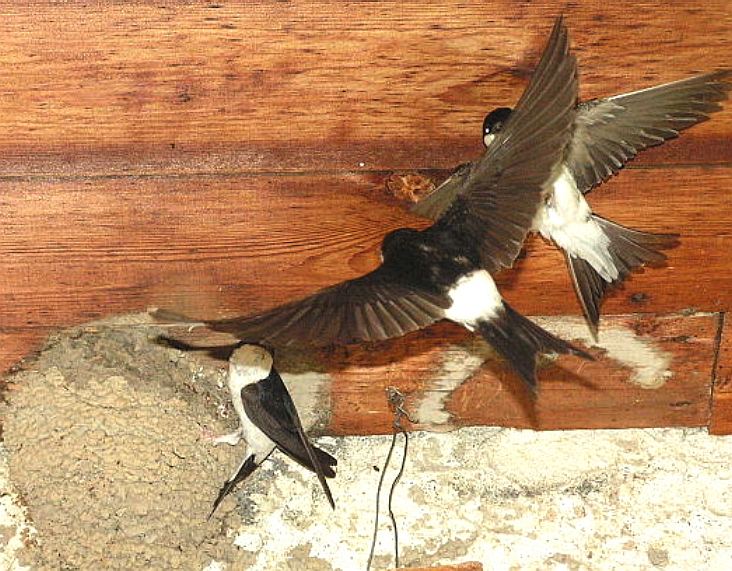
Eastern Bluebird
TAXONOMY
The Common House Martin was first described by Linnaeus in his Systema Naturae in 1758 as Hirundo
urbica, but was placed in its current genus Delichon by Thomas Horsfield and Frederic Moore in
1854. Delichon is an anagram of the Ancient Greek term χελιδών (chelīdōn), meaning
'swallow', and the species name urbicum (urbica until 2004, due to a misunderstanding of Latin grammar) means 'of the town' in
Latin.
The Delichon genus is a recent divergence from the Barn Swallow genus Hirundo, and its three members are similar in appearance with blue upperparts, a contrasting white-rump, and whitish underparts. In the past, the Common House Martin was sometimes considered to be conspecific with the Asian House Martin (D. dasypus), which breeds in the mountains of central and eastern
Asia and winters in Southeast Asia, and it also closely resembles the Nepal House Martin (D. nipalense), a resident in the mountains of southern Asia. Although the three Delichon martins are similar in appearance, only D. urbicum has a pure white rump and
underparts.
The Common House Martin has two geographical subspecies, the western nominate subspecies D. u. urbicum, and the eastern D. u. lagopodum, which was described by
German zoologist Peter Simon Pallas in 1811. Other races, like meridionalis from around the Mediterranean have been described, but the claimed differences from the nominate race are clinal, and therefore probably
invalid.
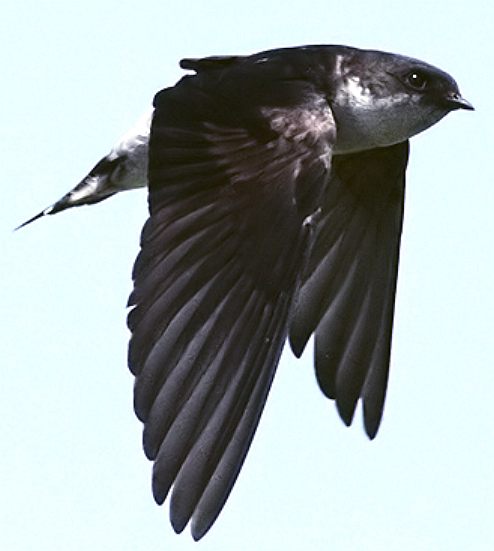
DESCRIPTION
The adult Common House Martin of the western nominate race is 13 centimetres (5.1 in) long, with a wing span of 26–29 centimetres (10.2–11.4 in) and a weight averaging 18.3 grammes (0.65 oz). It is steel-blue above with a white rump, and white underparts, including the underwings; even its short legs have white downy feathering. It has brown eyes and a small black bill, and its toes and exposed parts of the legs are pink. The sexes are similar, but the juvenile bird is sooty black, and some of its wing coverts and quills have white tips and edgings. D. u. lagopodum differs from the nominate race in that its white rump extends much further onto the tail, and the fork of its tail is intermediate in depth between that of D. u. urbicum and that of the Asian House
Martin.
The white rump and underparts of the Common House Martin, very noticeable in flight, prevent confusion with other widespread Palaeoarctic swallows such as the Barn Swallow (Hirundo rustica), Sand Martin (Riparia riparia) or Red-rumped Swallow (Cecropis daurica). In Africa, confusion with Grey-rumped Swallow (Pseudhirundo griseopyga) is possible, but that species has a grey rump, off-white underparts and long, deeply forked
tail. The Common House Martin flies with a wing beat averaging 5.3 beats per second, which is faster than the wing beat of 4.4 beats per second for the Barn
Swallow, but the flight speed of 11 m•s−1 (36 ft•s−1) is typical for
hirundines.
The Common House Martin is a noisy species, especially at its breeding colonies. The male's song, given throughout the year, is a soft twitter of melodious chirps. The contact call, also given on the wintering grounds, is a hard chirrrp, and the alarm is a shrill tseep.
DISTRIBUTION
The subspecies D. u. urbicum breeds across temperate Eurasia east to central Mongolia and the Yenisei River, and in Morocco, Tunisia and northern Algeria, and migrates on a broad front to winter in sub-Saharan Africa. D. u. lagopodum breeds eastwards of the Yenisei to Kolyma and south to northern Mongolia and northern China; it winters in southern China and Southeast Asia.
The preferred habitat of the Common House Martin is open country with low vegetation, such as pasture, meadows and farmland, and preferably near
water, although it is also found in mountains up to at least 2,200 metres (7,200 ft)
altitude. It is much more urban than the Barn Swallow, and will nest even in city centres if the air is clean
enough. It is more likely to be found near trees than other Eurasian swallows, since they provide insect food and also roosting sites. This species does not normally use the reed-bed roosts favoured by migrating Barn
Swallows.
It uses similar open habitats on the wintering grounds, but the Common House Martin is less conspicuous than wintering Barn Swallows, tending to fly higher and be more nomadic. In the tropical parts of its wintering range, like East Africa and
Thailand, it appears to be mainly found in the higher
areas.
The Common House Martin is a migrant which moves on a broad-front (i.e. European birds are not funnelled through the short sea crossings used by large soaring birds, but cross the Mediterranean and
Sahara). While migrating they feed in the air on insects, and they generally travel in daylight, although some birds may move at
night. Migration brings its own hazards; in 1974, several hundred thousand birds of this species were found dead or dying in the
Swiss Alps and surrounding areas, caught by heavy snowfall and low temperatures. Adult survival on autumn migration depends mainly on temperature, with precipitation another major factor, but for juveniles low temperatures during the breeding season are more
critical It is anticipated that since extreme weather is predicted to become more frequent with climate change, future survival rates will depend more on adverse weather conditions than at
present.
The Common House Martin returns to the breeding grounds a few days after the first Barn Swallows; like that species, particularly when the weather is poor, it seldom goes straight to the nesting sites, but hunts for food over large fresh water
bodies. There are records of migrant House Martins staying to breed in Namibia and South Africa instead of returning
north. As would be expected for a long distance migrant, it has occurred as a vagrant eastwards to Alaska and west to Newfoundland,
Bermuda and the Azores.
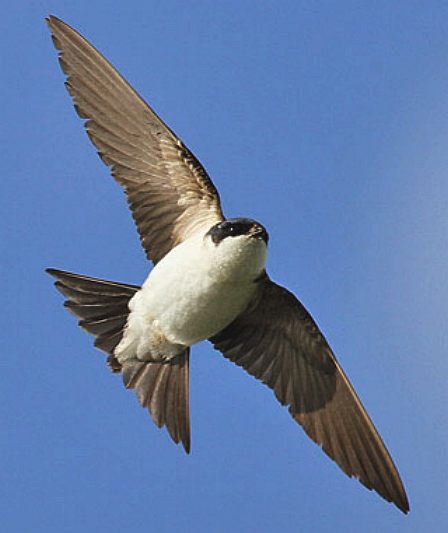
LITERATURE
This species lacks the wealth of literary references associated with its relative, the Barn Swallow, although it is possible that some of the older mentions for that bird might equally well refer to the House Martin. William Shakespeare was clearly describing the House Martin when Banquo brings the nests and birds to the attention of Duncan at Macbeth's castle, Inverness:
"This guest of summer,
The temple-haunting martlet, does approve
By his loved mansionry that the heaven's breath
Smells wooingly here. No jutty, frieze,
Buttress, nor coign of vantage, but this bird
Hath made his pendant bed and procreant cradle;
Where they most breed and haunt, I have observed
The air is delicate." (Macbeth, Act I, scene
VI).
There are old legends, with no basis in fact, that House Martins would wall-up House Sparrows by closing the entrance of the mud nest with the intruder inside, or that they would gather en masse to kill a Sparrow.
The martlet, often believed to refer to the House Martin, or possibly a swallow, was a heraldic bird with short tufts of feathers in the place of
legs. It was the cadency mark of the fourth son of a noble family, and features in many coats of arms, including the
Plantagenets. The lack of feet signified its inability to land, which explained its link to a younger son, also landless. It also represented swiftness.
BIRD INDEX:
|
Canary Chaffinch Chicken Cormorant Cuckoo Eagle Falcon Finch Grebe Grouse Hawk Herons Kingfisher |
Kiwi Loon Mynah Nightjar Owl Partridge Pelican Penguin Petrel Pheasant Quail Robin Seagull Sparrow Starling Stork Swan Swift Turkey Wader Woodcock Woodpecker
|
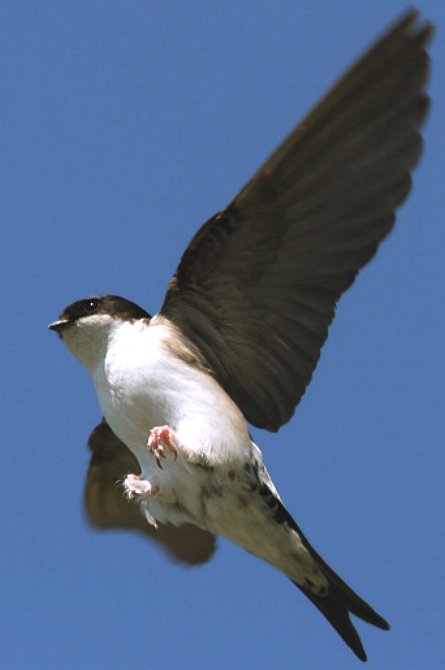
-
Bird Hybrids Database - Search by bird name, use Sibley classification
-
Birdlife International - Dedicated to bird conservation worldwide; has a database with about 250,000 records on endangered bird species
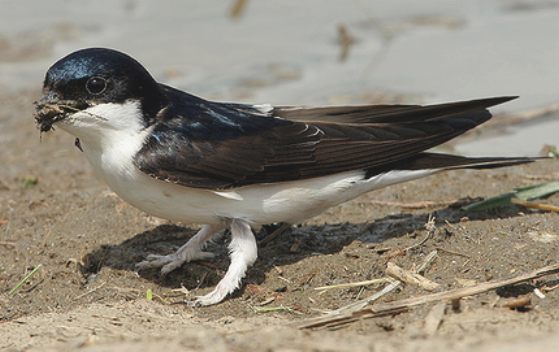
It's sad to think that one day, the planet Earth may be gone. This is despite our best efforts to save her. The good news is that provided we all work together, we can preserve the status quo on our beautiful blue world, for centuries to come. Provided that is we heed the warnings nature is sending us, such as global warming and other pollutions.
OTHER ANIMALS:
|
A heartwarming adventure: Pirate whalers V Conservationists,
with an environmental message.
This website is Copyright © 1999 & 2025 Electrick Publications & Blueplanet Netdirect Productions.
The bird logos and name Solar Navigator are trademarks. All rights reserved. Max Energy Limited is an educational charity working hard for world peace
